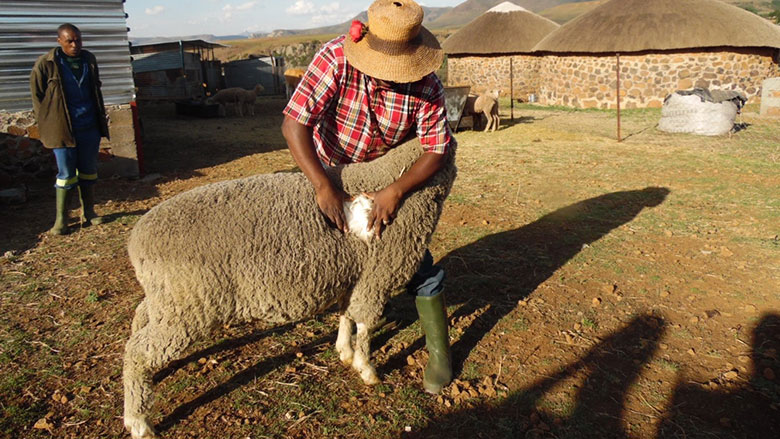MATELILE, December 28, 2016 – Since 2010, Koaile Seithleko has been rearing sheep in Ha Sello, Matelile, in the Mafeteng district of Lesotho. However, until this year, he has never made enough money to buy quality sheep, or build the structures necessary to protect them from harm.
With funds from the Smallholder Agriculture Development Project (SADP), his company, Seitlheko & Sons, was able to buy 40 Merino ewes and one ram. He was also able to build a shed to protect the livestock from harsh weather, which will allow him to raise Merino sheep with quality wool, an important export product in Lesotho.
“I’ve always dreamed of owning a sheep farm with such a protective structure,” Seithleko said. “My aim is to become the biggest Merino farmer in Lesotho; I plan on selling ewes and auctioning rams to local farmers to keep them from buying expensive sheep in neighboring South Africa.”
Although sheep farming is a potentially profitable industry in Lesotho, it has its challenges. Profits depend on the quality of sheep and subsequently the quality of wool produced. Sheep farmers lack the finances to buy quality sheep, and most cannot afford to house them properly. But with the SADP, which started in March 2012, smallholder farmers such as Seithleko have become more productive. Led by the Ministry of Agriculture and Food Security and supported by IDA, the World Bank’s fund for the poorest countries, the project provides a combination of competitive grants and technical assistance designed to increase the productivity and output of smallholder farming activities, and increase market opportunities.
To date, the $24.46 million project, which is co-funded by the International Fund for Agricultural Development (IFAD), has benefited more than 370 farmers, most of whom are women. Grant recipients include owners of protected farms such as greenhouses and shade nets, piggeries, wool and mohair producers, poultry farmers, and seed and seedling producers.
“This intervention has helped raise my level of farming,” said Thoahlane, a shade net owner from Sekamaneng. “I expect to double my tomato and green pepper yields under these shade nets bought with contributions from the SADP.”
More than half of Lesotho’s citizens live in rural areas, and the majority engage in subsistence agriculture. Because the urban economy has limited ability to absorb new entrants to it labor market, agriculture will continue to play a major role in Lesotho‘s development strategy. The SADP also aims to promote innovative agri-business initiatives which focus on ways to increase competitiveness, improve market access, add value and boost provision of services.
“Farming innovations can go a long way in enhancing rural economic growth in a sustainable manner,” said Mark Cackler, a practice manager in the World Bank Agriculture Global Practice. "We are pleased to partner with the Government of Lesotho in showing how improving the sustainable productivity and market access of smallholders can be a powerful mechanism to end poverty, especially in the rural areas of the country.”

